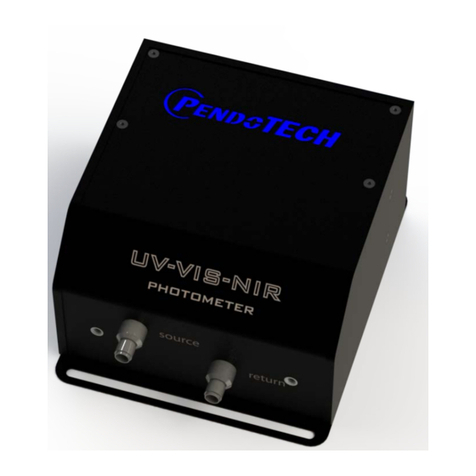
PendoTECH PM2 Photometer for UV Absorbance and Turbidity
Measurements User’s Manual Revision 0
www.pendotech.com Tel: +1-609-799-2299
Copyright © 2022 PendoTECH 1 | Page
Safety Instructions
Definition of Equipment and Documentation Symbols and Designations
WARNING: POTENTIAL FOR PERSONAL INJURY
CAUTION: Possible instrument damage or malfunction
NOTE: Important operating information
On the transmitter or in this manual text indicates Caution and/or other possible hazards, including the risk of electric
shock (refer to accompanying documents).
Each prospective user must test the measurement unit for its proposed application to determine its suitability for
the purpose intended prior to incorporating the sensor to any process or application. Proper safeguards must be
put into place for the process in which the unit is used.
The functioning and operational safety of the product can only be ensured if the user observes the usual safety
precautions as well as the specific safety guidelines stated in these operating guidelines:
The PM2 Photometer must only be operated under
the specified operating conditions.
The PM2 Photometer should be installed and
operated only by personnel familiar with the
Photometer and who are qualified for such work.
Before connecting the device to a supply unit, ensure
its output voltage cannot exceed 48 VDC. Do not use
alternating current or a main power supply!
Warning: Only use a power supply with double
insulation or reinforced insulation to supply this
product.
Warning: Do not submerge this product. Protect the
product before cleaning with any liquids by covering
openings that expose the internal components.
Install equipment as specified in this instruction
manual. Follow appropriate local and national codes.
Power supply must be disconnected before servicing.
The safety of the user may be endangered if the
instrument:
•is visibly damaged
•no longer operates as specified
•has been damaged in transport
Process upsets: because process and safety
conditions may depend on the consistent operation
of this transmitter, provide appropriate means to
maintain operation during sensor cleaning,
replacement, or sensor or instrument calibration.
Except for routine maintenance and cleaning procedures,
the PM2 Photometer must not be tampered with or altered
in any manner.
Maintenance and repair work must only be carried out by
PendoTECH.
METTLER TOLEDO/PendoTECH accepts no
responsibility for damage caused by unauthorized
modifications to the Photometer.
Follow all warnings, cautions, and instructions indicated
on and supplied with this product.
Electrical installation must be per the National Electrical
Code and/or any other applicable national or local codes.
If this equipment is used in a manner not specified by the
manufacturer, its protection against hazards may be
impaired.
Relay action: the PM2 Photometer relays will always de-
energize on the loss of power, equivalent to a normal
state, regardless of the relay state setting for powered
operation. Configure any control system using these
relays with fail-safe logic accordingly.
The terminals are suitable for single wires / flexible leads
0.2 mm2 to 1.5 mm2 (AWG 16 – 24).




























